Are you looking for ways to beat the heat and keep your tent cool during camping trips without relying on electricity? In this discussion, we’ll explore effective strategies on how to cool a tent without electricity. From choosing the right location and tent materials to utilizing natural ventilation and cooling techniques, we’ll uncover practical tips to ensure a comfortable and refreshing camping experience. Let’s dive in and discover how you can stay cool in your tent even in warm weather conditions, all while embracing the beauty of nature.
Table of Contents
Why do tents get hot?
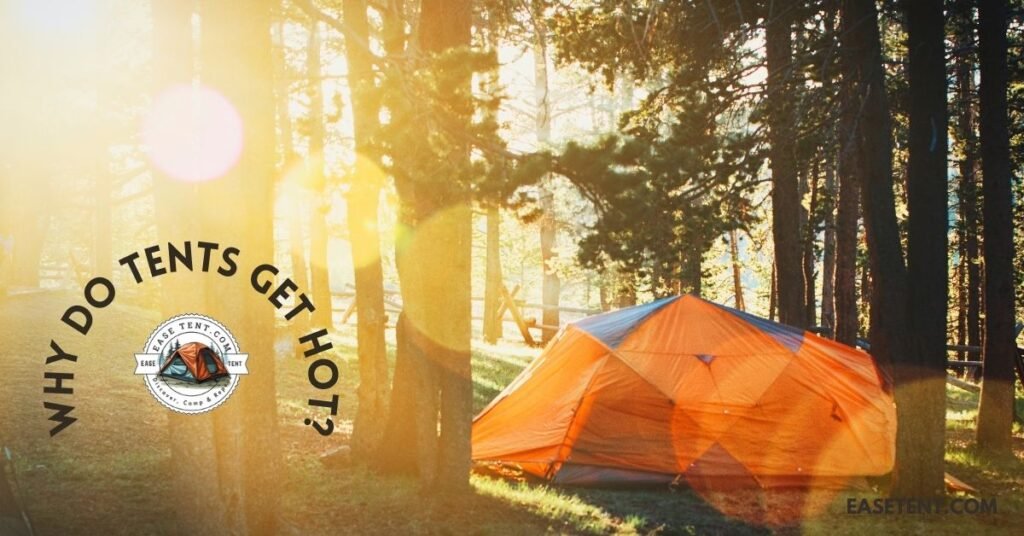
Tents can become hot primarily due to several factors related to heat absorption, insulation, and limited ventilation:
Body heat and Activities
When you’re inside a tent with others, your bodies naturally produce heat, which can raise the shelter temperature. Additionally, if you’re cooking or using a portable stove, that adds even more heat to the mix, plus, all the gear and stuff you bring, such as camping gear can also hold onto heat and contribute to the rising temperature inside the tent. So, it’s essential to think about managing heat and ventilation to keep things comfortable while camping.
Sunlight Absorption
Sunlight absorption occurs when the fabric of a tent absorbs solar radiation from the sun. This absorption leads to a spike in the temperature inside the camping structure, especially during sunny days. Dark-colored tents absorb more sunlight and heat compared to lighter-colored tents, as darker colors have higher thermal absorption properties. This heat absorption can make the tent’s interior uncomfortably warm, particularly during hot weather conditions.
Material Properties
The material properties of a tent refer to the characteristics of the fabric that was used for its building. Different tent materials have different levels of heat retention and breathability. For example, synthetic fabrics like polyester and nylon can trap heat inside the tent, which makes it feel warmer. In contrast, natural materials like cotton or canvas are more ventilated and can help regulate the temperature more effectively, although they may be heavier.
Limited Ventilation
Limited ventilation is defined as insufficient airflow or air circulation within a tent. When there is inadequate ventilation, the inside air of the tent gets stuck because the fresh air does not replace the tent’s warm air, which results in heat and humidity buildup. This can make the tent’s interior feel humid and uncomfortable. Enough ventilation is necessary to allow fresh air into the tent while eliminating heat and moisture, resulting in a more pleasant and breathable environment for campers.
External Weather Conditions:
External weather conditions are the atmospheric conditions outside of your tent or camping area. These conditions include humidity, wind speed, and temperature.
During camping, external weather conditions can significantly impact the quality of your stay. For instance, high temperatures and humidity can make the inside of your tent feel warmer and more humid, while strong winds can affect the shelter’s stability.
It’s critical to remember external climate factors when planning your tenting trip and to be prepared with appropriate gear and strategies to stay comfortable and safe regardless of the weather.
“Now I’m sure you will understand the reasons for hot huts; therefore, let’s jump into some tips that will assist you to stay cool and comfortable.”
Ventilation and Airflow
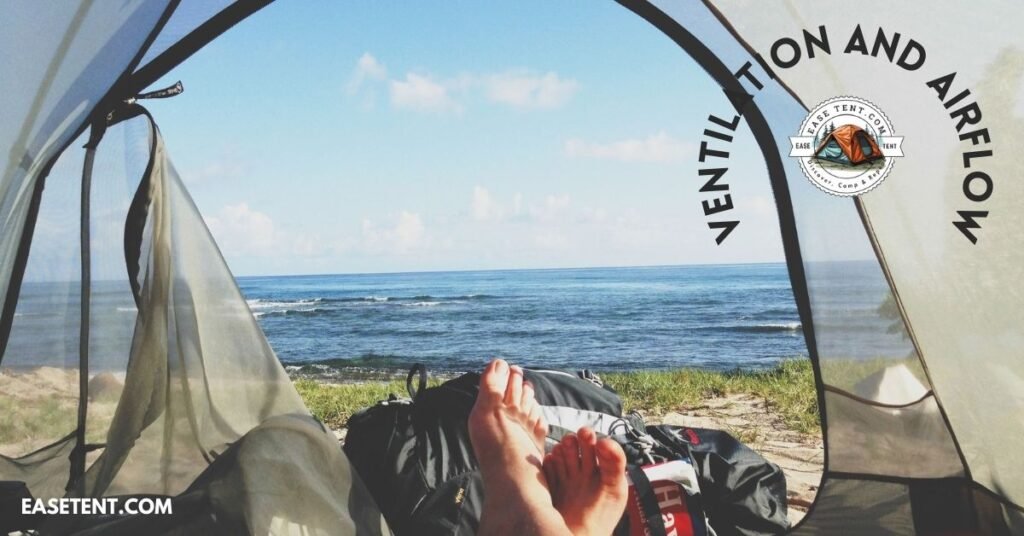
Choose the Right Location for Natural Ventilation
To enhance natural air circulation and keep your tent refreshing, choose a shaded location with a gentle breeze. Look for areas where trees and natural features can provide shelter from direct sunlight while permitting air to flow through. Place your tent in a way that prevailing winds are able to flow through open windows or doors, which will directly promote natural ventilation on the inside. Avoid low-lying regions that are likely to trap humid air and heat. By doing all these things you will create a comfortable camping atmosphere with better ventilation.
Shade and Sun Protection
Use a Shade Canopy
Using a shade canopy over your tent is an excellent way to reduce the heat while improving comfort during camping. When placing your shade canopy, ensure it covers your tent correctly and extends beyond its sides to create a larger shaded area. It helps to block bright sunlight and reduces heat absorption, thereby keeping the interior of your tent cooled particularly during the hottest parts of the day.
Always choose a canopy that is made from UV-resistant material to effectively block out harmful sunlight and provide reliable protection from UV rays. Position the awning strategically to achieve maximum shade coverage over your tent, especially when natural shade is limited in your camping area.
Additionally, keep in mind that a protective canopy should not hinder airflow around the tent because it permits proper ventilation and prevents heat from building inside your tent. You can also use the sheltered outdoor space provided by the canopy to relax, cook, or socialize while keeping the interior of your tent cooler and more comfortable.
In summary, employing a shade canopy is a useful and effective approach to reduce heat and sun exposure while out camping, which leads to a more enjoyable outdoor experience.
Uses of Reflective Tent Sheet
A reflective tent sheet is a useful instrument for keeping your tent cool and comfortable in warm conditions. Here’s how to get maximum use out of a reflective tent sheet:
By draping them over your tent, you can effectively reduce the heat absorption from the sun. Reflective materials bounce sunlight away by reflecting light rays off their surface, which helps to maintain a cooler interior temperature inside the tent.
Position the reflective sheet strategically on the outside of your tent and make sure it covers all the areas that are exposed to the sun.
While utilizing a reflective tent sheet, guarantee that there is adequate ventilation inside the tent to make space for air circulation and prevent condensation. Combine the reflective sheet with other cooling strategies like shade canopies and natural ventilation for optimal comfort during camping in hot weather.
In short, a reflective tent sheet is a useful accessory for minimizing heat and enhancing soothe during outdoor adventures, helping you make the most of your camping experience even in warm climates.
Cooling Techniques
Freeze water bottles
Freezing water bottles before your camping trip is an intelligent method to keep your food and drinks cool without the mess of melting ice. Use the frozen bottles in your cooler to aid in maintaining the appropriate temperature, and as they melt, you will use refreshing chilled water to drink. Plus, the frozen bottles are also suitable for use as makeshift ice packs to keep other perishable products chilled. This straightforward trick ensures that you’ve got a convenient source of cold water and assists in improving the cooling capacity of your cooler during your camping adventure.
How do you keep your camp cooler cold?
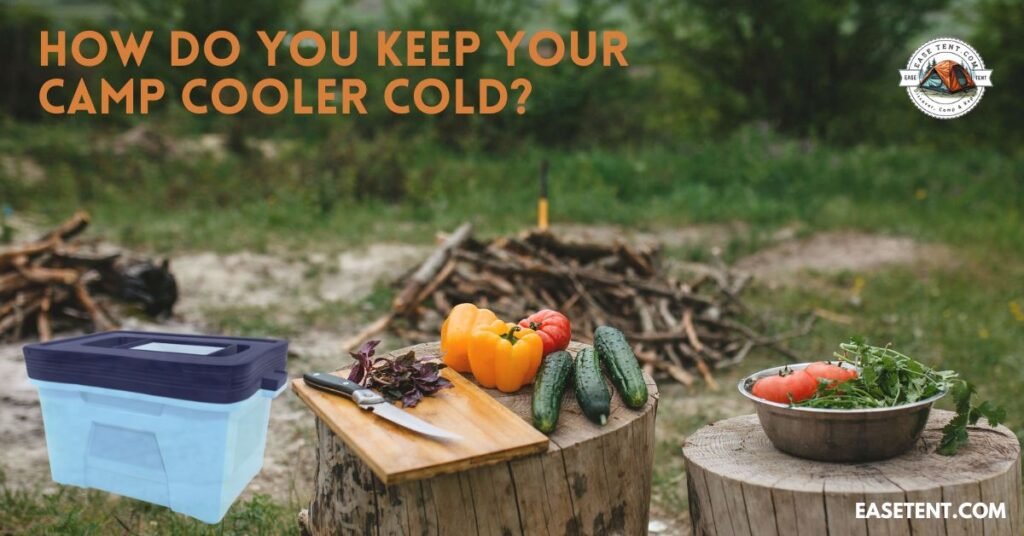
Keeping your camp cooler cold involves a few strategies to maintain low temperatures and preserve your food and drinks:
Use Ice or Ice Packs
Using ice or frozen packs in your cooler is vital for keeping your camp extraordinarily cold. Ice helps absorb warmth and maintain a lower temperature inside the cooler and chills your meals and beverages. Reusable ice packs are convenient and efficient alternatives to traditional ice, providing longer-lasting cooling without a mess of melted icy water. Be sure to pack your cooler generously with ice or ice bags to maximize cooling efficiency during your camping excursion.
Utilizing Dry Ice
Using dry ice in your cooler is a great way to keep your camp cooler chilled for a long time. Dry ice is solid carbon dioxide that turns directly into gas without melting into water like regular ice. It stays incredibly cold, around -109.3°F (-78.5°C), which helps to keep your cooler contents chilled for an extended amount of time. But there’s also a drawback of dry ice: every time you decide to use it, you must wear gloves for handling it because dry ice will affect your skin and cause redness and some other skin-related issues.
Pre-Chill Items
Store items in your cooler that are already chilled or frozen before placing them inside. This reduces the strain on the ice and helps keep the overall temperature colder for longer.
Keep Cooler Closed
Keeping your cooler sealed is necessary for preserving its frigid temperature. Every time you open the chilled cooler, it allows the warm air to get in and quickly increase the internal temperature, which will certainly decline its effectiveness and increase the chances of food spoilage. To preserve the inside chilly temperatures, you must minimize opening the cooler by opening it only whenever necessary and closing it promptly after retrieving items. This improves the efficacy of the ice or ice packs and preserves the freshness of your food and drinks while camping.
Use Insulating Materials
You can also wrap your chiller in blankets or towels to provide additional insulation and reduce heat transfer from the surrounding environment.
Position Cooler in Shade
Positioning your cooler in a shaded area helps to prevent direct sunlight from heating it, which can quickly warm the items inside. By keeping your cooler in a shaded location, you can preserve a cooler internal temperature and prolong the performance of the ice.
How many ice packs for a cooler?
The number of ice packs needed for a cooler depends on several factors, including the size of the cooler, the ambient temperature, and how long you need to keep items cold. As a general guideline:
Ratio
Aim to use approximately 1/2 to 2/3 pounds (0.23 to 0.3 kg) of ice per quart (0.95 liters) of cooler capacity. For example, a 50-quart (47 liters) cooler would need about 25 to 34 pounds (11 to 15 kg) of ice or ice packs.
Insulation Quality
If the quality of your cooler is excellent and has lasting insulation, you may require fewer ice packs. Conversely, a less insulated cooler may need more ice packs to maintain cold temperatures.
Type of Ice Packs
Consider using a combination of large and small ice packs to optimize space and cooling efficiency inside the cooler.
Duration of Cooling & Weather
If you are going on shorter trips and the campsite weather is not much high then fewer ice packs may be enough, whereas longer trips or extreme temperatures may require more ice packs or replenishing with fresh ice.
Additional Tip
(If Possible) Pre-chilling the cooler and its contents before adding ice packs can help reduce the amount of ice needed.
Strategic Timing
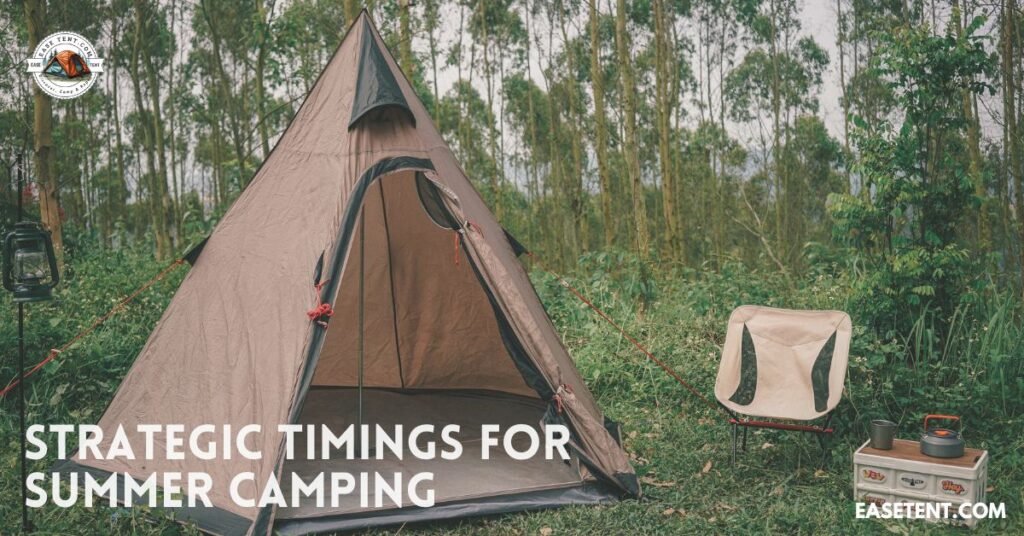
Placing a tent during the cooler time of the day
Placing your tent during the cooler time of the day is a smart strategy to ensure a more comfortable camping experience. This typically means setting up your tent early in the morning or late in the afternoon when temperatures are lower compared to midday.
By pitching your tent during cooler hours
- You will avoid direct contact with the sun’s intense heat, which makes the setup process more comfortable.
- By avoiding ultraviolet rays, you can reduce the risk of sunburn and skin damage. The cooler temperatures make it easier to work efficiently and minimize the risk of overheating.
- Your tent will be situated in a cooler spot, which can help regulate the temperature inside the tent throughout the day and night.
What is the best time of year to go camping?
The best time of year to go camping can vary depending on personal preferences and the type of camping experience you’re seeking. Here are considerations for different seasons:
Spring (March to May)
Mild temperatures and blooming landscapes.
Ideal for enjoying wildflowers, greenery, and moderate weather.
You may encounter some rain in certain regions (Sometimes also an adventure for some Enthusiasts).
Summer (June to August):
Warmest months for camping and outdoor activities.
The most preferred weather for camping according to campers.
Longer daylight hours for extended adventures.
A popular time for camping, but can be crowded at popular destinations.
Fall (September to November):
Cooler temperatures and colorful foliage.
Less crowded than summer months.
Good for hiking, leaf-peeping, and enjoying crisp air.
Winter (December to February)
Suitable for winter camping and snow-related activities.
Requires special gear and preparation for cold weather camping.
Quieter and less crowded at many campgrounds.
The best time for camping ultimately depends on your preferred weather conditions, outdoor activities, and availability. Also, what time suits your schedule? Consider factors like temperature, precipitation, and seasonal activities when planning your camping trip to ensure an enjoyable and comfortable experience.
Personal Cooling
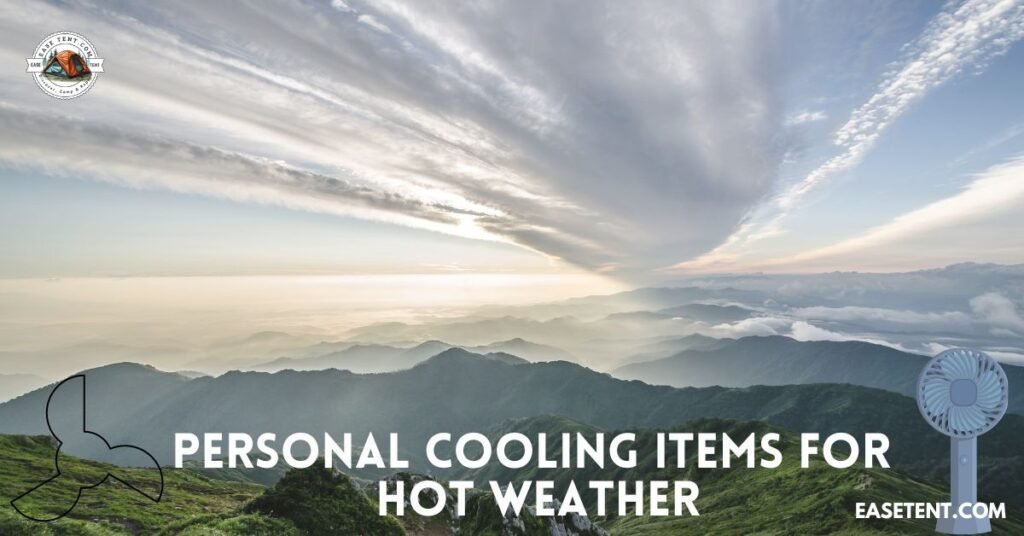
Battery Operated fans
Battery-powered fans are a fantastic option for staying cool and comfortable during outdoor activities, especially when you are camping in warm weather. These compact fans are powered by batteries or USB and provide a constant breeze to help lower your body temperature.
You can use a battery-powered fan to:
Create a refreshing airflow inside your tent to combat stuffiness on hot days.
Carry the fan with you while hiking or exploring to stay cool and refreshed.
Place the fan near your sleeping area at night for better sleep and comfort.
Battery-powered fans are portable, lightweight, and easy to use, making them a practical choice for personal cooling during camping trips and outdoor adventures. They’re a great addition to your camping gear for keeping cool when traditional air conditioning isn’t available.
Create Your Natural Air Conditioner
Creating a natural air conditioner involves using simple techniques to cool down your immediate environment without relying on electricity. Here’s how you can do it:
DIY Swamp Cooler
A DIY swamp cooler is a simple and effective way to cool down your environment by using basic resources. Here’s how you can create one:
- Materials Needed
- A large bowl or container
- Ice cubes or cold water
- A Battery-operated or solar fan
- Setup
- Fill the selected bowl with ice cubes or cold water.
- Place the bowl in front of a fan, and ensure the fan’s face is towards you.
- Operation
- Turn on the fan. As the fan blows air over the ice or cold water, it picks up moisture and creates a cool wind like a swamp cooler.
- Maintenance
- After a specific period of time, monitor the water level in the container and top it off with ice or chilled water if necessary to keep the cooling process going.
- Empty and refill the bowl on a regular basis to prevent stagnation while keeping it fresh.
A DIY swamp cooler is an affordable and energy-efficient way to beat the heat, whether you’re camping, working in a garage, or relaxing in your yard. Experiment with different fan speeds and positioning to optimize the cooling effect based on your preferences.
Cross-Ventilation
Cross-venting is a natural and effective technique for chilling indoor spaces by utilizing air circulation to replace the interior air with fresh outdoor air. To achieve cross-ventilation, start by opening windows and doors on opposite sides of the room or space. This allows cooler outdoor air to enter through the opening while warm indoor air escapes through the other.
To enhance cross-ventilation, you can also make use of fans by placing them inside an open window or door to suck in external air and another facing outward to remove indoor air. This setup will take your cross ventilation to the next level by producing a fast and efficient airflow pattern.
Remember to implement this cross-ventilation process always in cooler times of the day, such as early morning or late evening, when outdoor temperatures are lower. You can also do this process by using wet sheets or towels (The guide is listed below).
Air conditioning via Wet Sheets or Towels
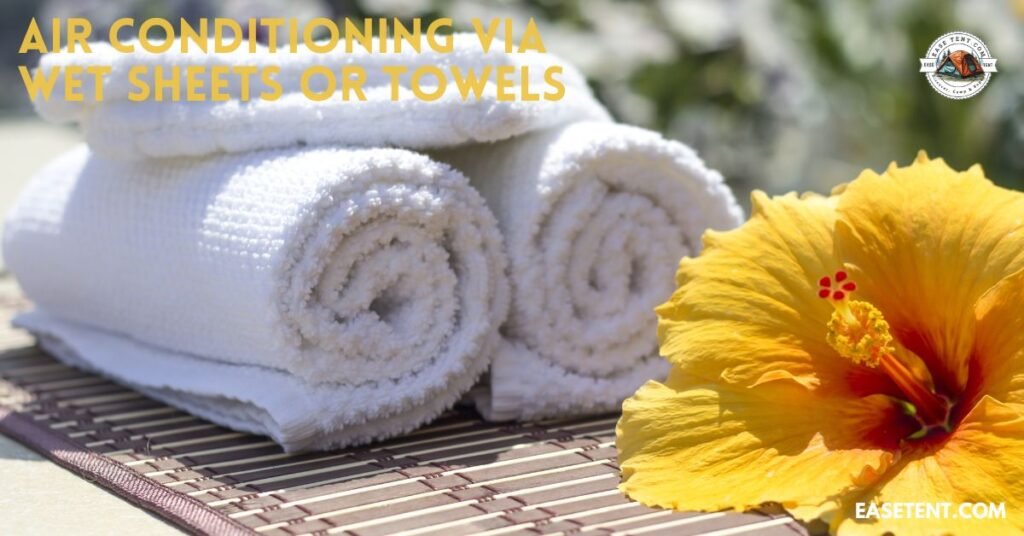
Using wet sheets or towels is another practical and accessible method for cooling down indoors. To use this technique effectively, start by submerging a clean sheet or towel in cold water until it becomes thoroughly soaked. Then, gently wring out the excess water to prevent dripping and water mess.
Next, find a suitable location to hang the wet sheet or towel where there is airflow, such as in front of an open window or an entranceway. As air passes through or over the damp fabric, it picks up moisture and undergoes evaporative cooling. This process helps lower the temperature in the surrounding area and provides a refreshing and natural cooling effect.
Alternatively, you can use the damp towel directly on yourself by draping it over your body or wrapping it around your neck and shoulders. This allows the evaporative cooling to directly cool your skin, offering relief from the heat.
Using wet sheets or blankets for cooling is an economical and eco-friendly alternative for air conditioning, especially for dry climates where evaporative cooling is particularly effective. Whether you’re indoors during a heat wave or camping under the sun, using soaked layers for the cooling method will make a significant difference in staying cool and comfortable without relying on electricity.
Choosing Appropriate Clothing
Choosing the right clothing for outdoor activities is crucial for staying comfortable, safe, and cool, especially in warm weather conditions. When selecting clothing, consider several factors to ensure optimal performance and comfort.
Breathable Fabric
Firstly, pay attention to the fabric of your clothing. Opt for lightweight and breathable materials such as cotton or moisture-wicking synthetics. These fabrics allow air circulation, which helps to keep you cool by allowing sweat to evaporate more easily.
Coverage from UV rays
Secondly, consider the degree of protection you get from the clothes you’re wearing. In sunny conditions, it’s important to protect your skin from damaging ultraviolet (UV) rays, especially when you are out hiking or on a camping trip. Choose outfits with long sleeves and pants that are composed of UV-protective materials to minimize sun exposure.
Color of the fabric
Color choice also plays a role in keeping you cool. Light-colored clothing reflects sunlight, whereas darker shades absorb heat and lead to thermal energy. Therefore, wearing pale-colored garments can help to maintain a cooler body temperature.
Additionally, wear clothes that have a loose fitting because Loose-fitting outwear improves airflow and ventilation, minimizing heat retention and increasing overall comfort during outdoor activities.
Lastly, don’t forget to accessorize appropriately. Wear a wide-brimmed hat to shade your face and neck from the sun, along with sunglasses to protect your eyes. Choose comfortable footwear designed for outdoor activities to ensure support and protection for your feet.
By carefully selecting and wearing appropriate clothing based on these considerations, you can optimize your comfort, safety, and enjoyment during outdoor adventures in warm weather.
“Adventure is calling, and sunscreen is answering the UV challenge.”
By; M Saif
Sleep Comfortably with a Damp Cotton T-shirt
You can also dampen your sleeping shirt before going to bed it provides a calming sensation as the water evaporates from the fabric overnight. This method can be effective for staying cool in hot weather, especially when air circulation is available to aid in the evaporation process.
Merino Wool Clothing
Merino wool clothing is highly valued for its exceptional qualities that make it an excellent choice for outdoor activities. This type of wool comes from Merino sheep, which are known for producing fine, soft fibers that are comfortable to wear against the skin.
Breathability
One of the standout features of Merino wool is its breathability. The natural structure of Merino fibers allows air to circulate, helping to regulate body temperature. This means that Merino wool keeps you cool in warm weather by wicking moisture away from the skin and warm in cold weather by providing insulation.
Moisture Absorbing
Another key benefit of Merino wool is its moisture-wicking properties. Unlike cotton, which can become damp and uncomfortable when it’s wet, Merino wool can absorb moisture without feeling soggy. This makes it a great choice for activities that involve sweating, as it helps keep you dry and comfortable.
Odor Resistant
Merino wool also has inherent odor-resistant properties due to its antimicrobial nature, due to its antimicrobial nature it inhibits the growth of microorganisms that cause smells. This makes Merino wool garments suitable for extended wear during multi-day outdoor camping adventures without the need for frequent washing.
In addition to its functional benefits, Merino wool is prized for its softness and comfort. It feels gentle against the skin and doesn’t cause itching or irritation, even when worn for long periods.
Overall, Merino wool clothing is versatile and suitable for a wide range of outdoor activities, including hiking, camping, skiing, and everyday use. Its natural properties contribute to enhanced comfort, performance, and durability, making it a favorite choice among outdoor enthusiasts seeking high-quality clothes for varying weather conditions.
Cool Down with Damping Hairs
Dampening your head with water is an effortless and efficient approach for staying cool while camping or performing other outdoor activities. When water evaporates from wet hairs, it helps to dispel the heat from your entire body, resulting in a cooling sensation. This natural evaporative cooling procedure can be particularly refreshing on hot days or after intense workouts. Furthermore, wet hair might help you stay more comfortable when you’re outside, which leads to an improved overall camping experience.
Choosing the Right Tent
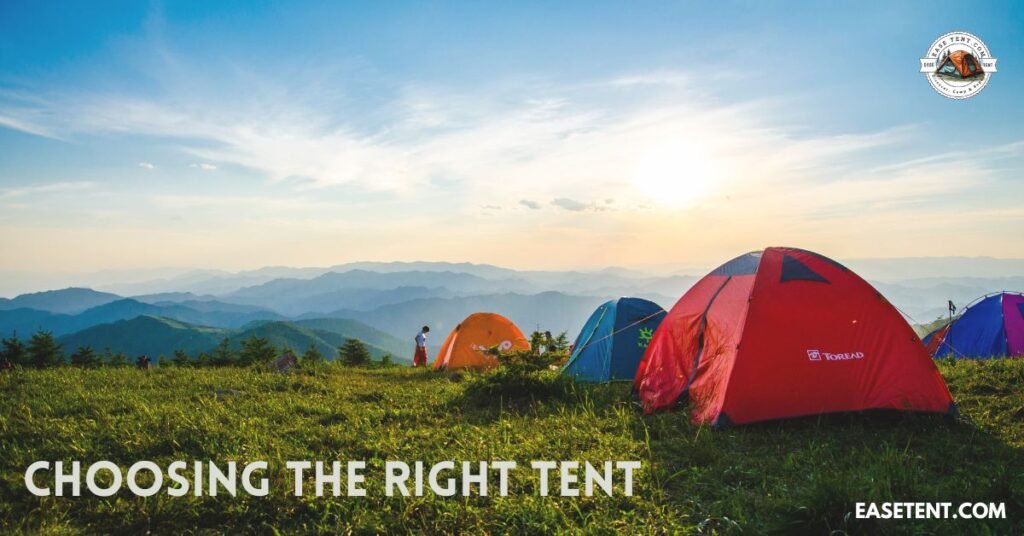
Tent Material Matters A Lot
Certainly! When camping on hot days, choosing the right tent material can make a big difference in your comfort level. All of my favorite hot day’s tent choices are listed below:
Nylon Tents
Nylon tents are a popular choice for camping in warm weather due to their lightweight and breathable properties. Nylon is an artificial material known for its durability and versatility in outdoor sets.
You know how important it is to keep things light when you’re hiking or backpacking, right? Well, nylon tents are perfect for that—they’re easy to carry and don’t weigh you down.
- Breathability
- Plus, the breathable nature of nylon means that air can flow through the fabric, keeping the inside of the tent cooler when it’s hot outside.
- This airflow is really important for staying comfortable during those sunny days at the campsite.
- Quick-Drying:
- Oh, and here’s another cool thing about nylon tents: they dry super quickly.
- So, if you get caught in a rain shower or if there’s condensation inside the tent, the nylon fabric dries out fast, keeping you and your gear dry.
- Durability:
- Nylon tents are also tough and durable.
- They can handle rough outdoor conditions without tearing easily, which is great for camping in different environments.
- UV Resistance:
- And guess what? Many nylon tents have UV-resistant coatings to protect against sun damage.
- That means they last longer and stay looking good even after being exposed to the sun for long periods.
So, if you’re planning a camping trip in warm weather and want a tent that’s lightweight, breathable, quick-drying, and durable, consider going with a nylon tent. It’s a smart choice for staying comfortable and enjoying your outdoor adventures to the fullest!
Polyester Tents
Let’s talk about polyester tents—they’re another fantastic option for your camping, especially in warmer weather. Polyester is a synthetic material that offers some unique benefits for outdoor use:
- Ultraviolet Rays Resistant
- First off, polyester tents are known for their durability and resistance to UV rays.
- This means they can withstand exposure to sunlight without degrading or fading as quickly as some other materials might.
- So, if you’re planning a camping trip where you’ll be setting up your tent in sunny conditions, a polyester tent could be a great choice for long-lasting performance.
- Pocket friendly
- Polyester tents also tend to be more affordable compared to some other types of tents, which is awesome if you’re looking for a budget-friendly option without sacrificing quality.
- They’re a great value for the money, offering durability and reliability without breaking the bank.
- Water-resistant
- In terms of water resistance, polyester tents can be treated with coatings or finishes that make them highly water-resistant or even waterproof.
- This is super important for staying dry and comfortable during unexpected rain showers or damp conditions.
- A drawback of Less Breathability
- One thing to keep in mind with polyester tents is that they may not be as breathable as some other materials like nylon.
- This means they might trap a bit more heat inside, especially on warmer days.
- However, many polyester tents come with mesh panels or vents to improve airflow and ventilation, helping to keep you cool and comfortable inside.
Overall, polyester tents are a versatile and practical choice for camping in various conditions, offering durability, affordability, and weather resistance. Whether you’re planning a weekend getaway or a longer outdoor adventure, consider a polyester tent for reliable shelter and peace of mind during your camping experience.
Canvas Tents
Canvas tents are also a great option for camping on hot days due to their unique properties that provide excellent insulation and comfort. Here’s why canvas tents are another beneficial option for hot-weather camping:
- Ventilation and Insulation
- Canvas tents have been praised for their exceptional ventilation and insulation.
- Unlike synthetic fabrics, canvas allows air to pass through while providing protection against thermal energy.
- This natural ventilation helps keep the interior of the tent refreshing during summertime and creates an inviting atmosphere for camping.
- Protection from Sunlight
- Canvas tents also have the ability to block out sunlight effectively, because of their dense fabric.
- This feature helps reduce the amount of heat that enters the tent, keeping it cooler and more shaded compared to other tent materials.
- Durability and Endurance
- Another advantage of canvas tents is their durability and longevity.
- While canvas tents may be heavier than nylon or polyester tents, they are robust and can withstand extended use in various weather conditions, including scorching days.
Overall, canvas tents are an excellent choice for summer camping if you prioritize comfort, insulation, and durability. Their natural breathability and heat-blocking properties make them ideal for staying cool and relaxed during summer camping trips. However, keep in mind that canvas tents may require more care and maintenance compared to synthetic tents to ensure their longevity and performance.
Mesh Tents
Mesh tents, also identified as mesh-sided tents or screen tents, are a popular choice for camping in hot weather due to their excellent ventilation and bug protection. Mesh tents are a fantastic choice for remaining cool and cozy on hot days for multiple reasons:
- Maximum Air Circulation
- Mesh tents are designed with predominantly mesh walls or panels, which allow for maximum air circulation.
- The mesh fabric allows air to circulate freely throughout the tent, promoting natural cooling by facilitating air exchange inside and outside the camp.
- Protection from Insects
- One of the key advantages of mesh tents is their ability to keep insects and bugs out while still providing ample airflow.
- The tight weave of the mesh fabric acts as a barrier against mosquitoes, flies, and other pests, allowing you to enjoy fresh air without the irritation of bugs.
- Lightweight
- Mesh tents are lightweight and compact, making them easy to carry and set up.
- They are ideal for backpacking or minimalist camping trips where reducing weight and bulk is important.
Overall, mesh tents are a fantastic choice for hot-weather sleepouts if you prioritize ventilation, bug protection, and lightweight design. They provide a comfortable and breathable shelter option for outdoor enthusiasts seeking to stay cool and enjoy the natural surroundings during their camping adventures.
Ultimately, when selecting a tent material for hot days camping, prioritize breathability and ventilation to ensure a comfortable camping experience. Look for tents with ample mesh panels, vents, or breathable fabrics that allow for proper airflow and help regulate temperature inside the tent.
Look for Larger Tents
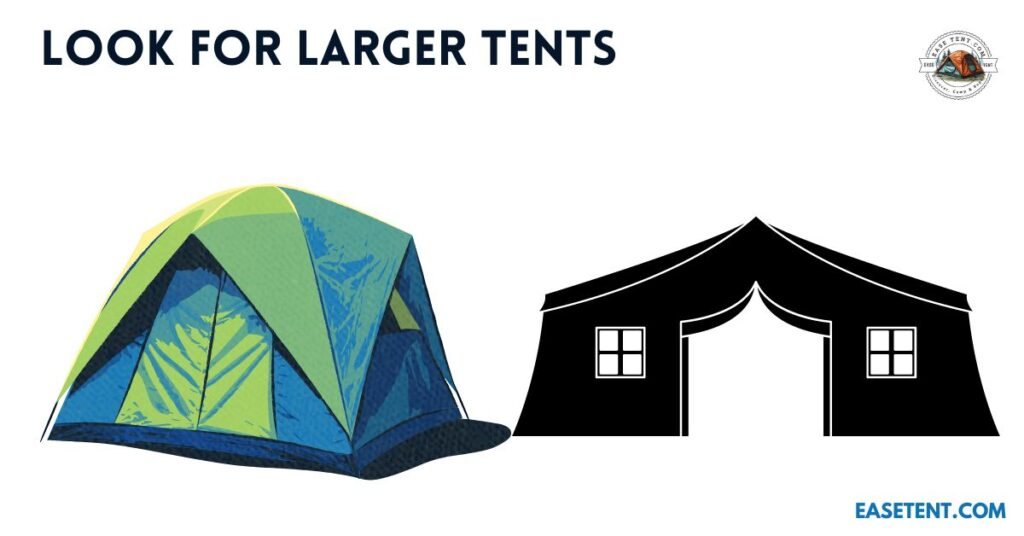
Choosing a larger tent for camping in warm weather can significantly enhance your relaxation and overall camping experience. Larger tents offer several benefits that contribute to better airflow, ventilation, and convenience.
Improved Air Circulation
Initially, larger tents provide improved air circulation compared to smaller tents. With more interior space, air can move more freely within the tent, which helps to disintegrate heat and maintain a cooler environment. This increased airflow is especially beneficial when ventilation is required for comfort on summer days.
Optimal Ventilated Arrangement
Additionally, having a larger tent allows for a more airy setup inside. You can arrange sleeping areas further apart which will provide healthier airflow around each sleeping space. This setup helps prevent heat from rapt in specific areas of the tent, contributing to a more comfy sleeping environment.
Additional Space
Another advantage of larger tents is the ample storage space they offer. With more room inside, you can organize your gear more effectively, keeping living areas clutter-free and allowing for better airflow throughout the tent. This organized setup not only enhances comfort but also promotes a more enjoyable camping experience.
Shady Areas
Moreover, the larger footprint of a tent can provide additional shaded areas outside the tent entrance. This shaded space offers a comfortable area to relax during the day without direct exposure to the sun’s heat, further enhancing your relief during hot weather camping.
More Privacy
In terms of privacy and overall comfort, a larger tent allows for more room to move around and perform daily activities comfortably. Whether you’re changing clothes, relaxing, or spending time with family and friends inside the tent, the extra space contributes to a more enjoyable and accommodating camping environment.
When selecting a larger tent for hot weather camping, consider features like mesh windows, vents, or breathable materials to optimize airflow and ventilation inside the tent. These considerations will help ensure a cooler and more comfortable camping experience, allowing you to fully enjoy your outdoor adventures even in warm weather conditions.
Tent Color:
The color of your tent can significantly impact your comfort and overall camping experience, especially in hot weather.
Light Colors Reflect Heat
Lighter-colored tents, such as white, light gray, or pastel shades, are preferred for camping in warm conditions because they reflect sunlight rather than absorb it. This reflective property helps to keep the interior of the tent cooler by dropping the amount of heat that penetrates through the fabric. As a result, choosing a lighter-colored tent can contribute to a more relaxed environment during the day and night, helping to regulate temperature and prevent overheating.
Dark Colors Absorb Heat
Conversely, tents in darker colors, such as black, dark blue, or green, tend to absorb more heat from the sun. While these tents may offer better visibility and blend in with natural surroundings, they can also lead to a warmer interior temperature, especially on sunny days. Therefore, darker-colored tents may be less ideal for camping in hot weather, as they can contribute to higher temperatures inside the tent.
Comfort and Temperature Regulation
The choice of tent color also impacts visibility and safety during camping trips. Lighter-colored tents are more visible in various outdoor environments, which can be advantageous for locating your campsite and enhancing safety, particularly at night. However, darker-colored tents may blend in better with certain landscapes and provide better camouflage in wilderness settings.
Ultimately, the decision on tent color comes down to personal preference, climate considerations, and specific camping needs. When selecting a tent color for hot weather camping, prioritize light-colored options to maximize heat reflection and maintain a cooler interior temperature. Consider the terrain, visibility requirements, and overall aesthetics to choose a tent color that best suits your camping environment and enhances your comfort and enjoyment outdoors.
How to protect your tent from the sun?
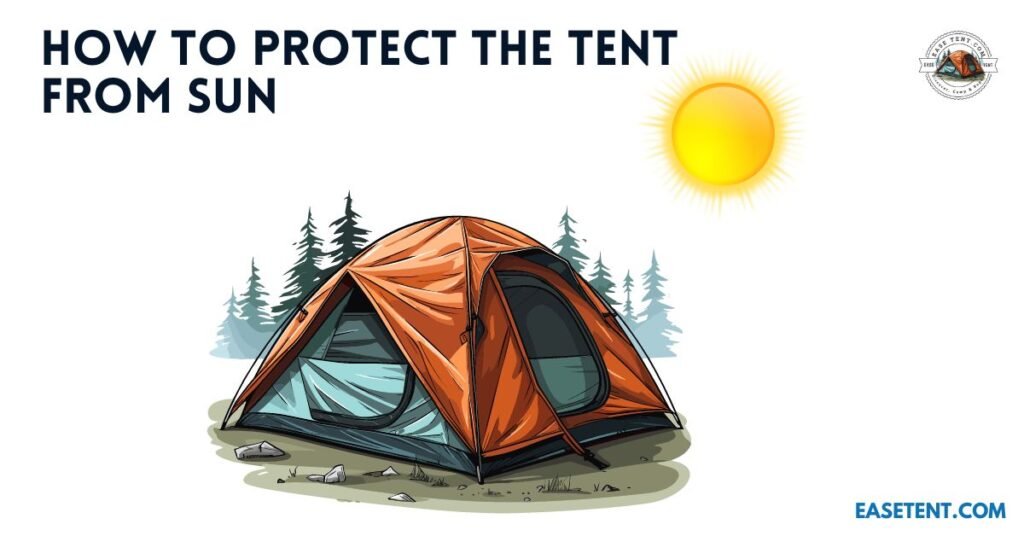
Protecting your tent from sun damage is essential for maintaining its durability and ensuring your bank account doesn’t get hurt. Some tips related to it;
Choose a Shaded Campsite
One of the best ways to safeguard your tent from the sun is to select a shaded campsite whenever possible. Choose a location with natural shade provided by trees, rocks, or other structures to minimize direct sunlight exposure to your tent throughout the day.
Use a Tent Footprint or Ground Tarp
Using a tent footprint or ground tarp beneath your tent is another effective strategy for sun protection. These additional layers act as a barrier between the tent floor and the ground, reducing abrasion and shielding the tent fabric from UV rays. It’s important to secure the footprint properly to prevent it from extending beyond the edges of the tent, which can collect rainwater and compromise the tent’s waterproofing.
UV Protection Spray
Applying a UV protection spray to your tent fabric can significantly enhance its resistance to UV rays and minimize sun damage. These specialized sprays are designed for outdoor gear and help prevent fading and deterioration caused by prolonged exposure to sunlight. Be sure to follow the manufacturer’s instructions when applying UV protection spray to ensure maximum effectiveness.
Make Use of Rainfly or Sunshade
Using a rainfly or sunshade over your tent, even on sunny days, provides an additional layer of defense against UV rays and helps keep the interior cooler by providing shade. Make sure to properly set up and secure the rainfly to cover the entire tent and maximize protection from the sun.
Ventilation
Proper ventilation is key to preventing heat buildup and moisture accumulation inside the tent. Keep windows, doors, and vents open whenever possible to allow for airflow, which can reduce the impact of direct sunlight on the tent material. Additionally, avoid prolonged sun exposure by packing up your tent during the day or when not in use to minimize UV exposure and prolong its lifespan.
Regularly inspect your tent for signs of sun damage, such as fading colors, weakening of fabric, or brittle seams. Address any issues promptly to prevent further deterioration and maintain the performance and longevity of your tent. By taking these proactive measures to protect your tent from the sun, you can ensure that it remains in optimal condition for many camping adventures to come, providing reliable shelter and comfort in various outdoor environments.
Additional Tips
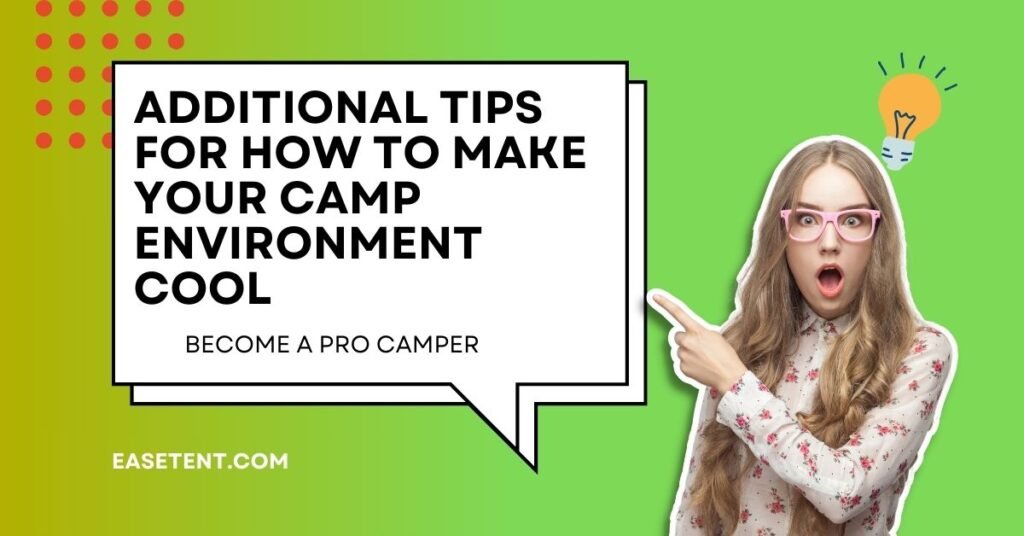
How much water do you need when camping?
The quantity of water required when camping varies depending on several factors, including the duration of your trip, weather conditions, activity level, and individual hydration needs. Here are some general suggestions for estimating how much water to bring when camping:
Daily water intake
The amount of water needed for camping varies based on several factors that influence hydration requirements. As a general guideline, campers should aim to consume between 2-4 liters (about half to one gallon) of water per day. However, this estimate can fluctuate depending on individual factors such as age, gender, activity level, climate, and overall health.
Weather situations & Activity level
Weather conditions play a significant role in determining hydration needs. Hot and dry environments, as well as energetic activities like hiking or biking, increase fluid loss in the form of sweat. In such conditions, it’s crucial to drink more water to replace lost water levels and prevent dehydration. Additionally, the duration of the camping trip impacts the amount of water required. Longer excursions necessitate greater water supplies to sustain hydration throughout the journey.
Water Sources
Access to potable water sources at the camping site is another consideration. If clean water is not readily available, campers must bring sufficient water supplies or utilize effective water purification methods to ensure safe drinking water. Altitude, humidity levels, and individual health conditions also impact hydration needs which makes it essential to monitor fluid intake and respond to the body’s signals for thirst.
To accurately estimate water requirements for camping, campers should plan ahead based on anticipated conditions and activities. Packing adequate water supplies, along with portable water purification tools, ensures readiness for varying circumstances and helps maintain optimal hydration levels during outdoor adventures. Prioritizing hydration is essential for overall well-being and enjoyment while camping, especially in remote or challenging environments where access to water may be limited.
Nighttime Cooling
Nighttime cooling during camping, especially in warmer temperatures, is crucial for a restful and comfortable sleep. One effective strategy is to use lightweight sleeping gear that is specifically designed for warmer conditions. Here’s how opting for appropriate lightweight sleeping gear can enhance nighttime cooling:
Lightweight Sleeping Bag
Choosing a lightweight sleeping bag or sleeping quilt made from breathable materials like nylon or polyester can help regulate body temperature by allowing better airflow. Look for sleeping bags with lower temperature ratings suitable for warmer nights to prevent overheating.
Sleeping Pad or Cot
Consider using a sleeping pad or cot that promotes air circulation underneath your sleeping surface. Elevated sleeping platforms or pads with built-in insulation can provide better ventilation and cooling compared to sleeping directly on the ground.
Breathable Night Dress
In addition to lightweight sleeping gear, wear breathable clothing suitable for warm temperatures while sleeping. Opt for moisture-wicking fabrics like cotton or technical performance materials that help wick sweat away from the body, keeping you cool and dry throughout the night.
Ensuring Airflow
Before bedtime, ventilate your tent by opening windows, vents, or doors to encourage airflow and cool down the interior. Position your tent strategically to take advantage of natural breezes and cross-ventilation.
Avoid Heavy Blankets
Avoid overdressing or using heavy blankets in warm conditions. Instead, use a light blanket or sleep in minimal layers to prevent overheating during the night.
By using appropriate lightweight sleeping gear tailored for warmer temperatures, you can optimize nighttime cooling and ensure a more enjoyable camping experience, even in hot weather. Experiment with different gear combinations to find the setup that best suits your comfort and sleeping preferences while camping.
Minimizing Heat Sources
Minimizing heat sources inside your tent is essential for creating a comfortable and cooler environment during camping, especially in warm weather conditions. Listed below is the discussion related to this;
Keep Heat-Generating Items Outside
One effective strategy is to keep heat-generating items outside of the tent. This includes portable stoves, lanterns, and electronic devices that emit heat. By using these items outdoors, you can prevent excess heat buildup inside the confined space of the tent and reduce safety risks associated with indoor cooking or heating.
Limit Cooking Inside the Tent
Limiting cooking activities inside the tent is another key practice for minimizing heat sources. If cooking is necessary, use a camp stove or portable grill outside the tent to prevent elevated temperatures and potential fire hazards inside. This not only maintains a cooler tent interior but also ensures safer cooking practices during camping trips.
Use Battery-Powered Lighting
Opting for battery-powered lighting sources such as lanterns or LED lights instead of fuel-burning alternatives helps reduce heat emission inside the tent. Battery-powered lights produce minimal heat and eliminate the risk of accidental fires, providing a safer and cooler lighting option for nighttime camping activities.
Avoid Excessive Body Heat
Additionally, it’s important to avoid overcrowding inside the tent to minimize body heat accumulation. Limit the number of occupants and allow for adequate airflow around sleeping areas to maintain a comfortable temperature. Activities that generate heat should be planned outdoors, such as cooking or hiking, also be performed during cooler times of the day to minimize their impact on the tent’s interior temperature.
Optimize airing
Enhancing ventilation by keeping tent windows, doors, and vents open promotes airflow and facilitates heat dissipation. Cross-ventilation helps draw in cooler air and expel warm air, contributing to a more pleasant camping environment.
Use Reflective Sunshades
Using reflective sunshades or tarps over the tent can further deflect sunlight and reduce heat absorption, especially during sunny days.
By implementing these heat-minimizing strategies, you can effectively create a cooler and more enjoyable camping experience. Prioritizing ventilation, avoiding heat-generating activities inside the tent, and using reflective materials contribute to optimizing comfort and safety during warm-weather camping trips. Adjust these practices based on specific camping conditions and preferences to ensure a comfortable and relaxing outdoor adventure.
FAQs
Will a fan cool a tent?
Yes, a fan can help cool a tent by improving air circulation and promoting evaporative cooling. While it won’t lower the temperature like an air conditioner, a fan can create a more comfortable environment by circulating air and enhancing ventilation inside the tent. Using a fan alongside other cooling strategies, such as shading and proper ventilation, can effectively reduce heat buildup and increase overall comfort during camping.
Can you put a portable AC in a tent?
Yes, putting a portable air conditioner in a tent is technically possible but not always useful. Portable AC units require a power source and produce heat exhaust, which can pose challenges in a tent environment. Additionally, they may not be effective in cooling larger tent spaces and can be bulky to transport and set up during camping trips.
How do you keep a yurt cool?
To keep a yurt cool, maximize ventilation by opening windows and doors to encourage airflow. Use reflective insulation or shade cloths on the exterior to minimize heat absorption. Additionally, employ evaporative cooling methods like wet towels or portable fans to lower temperatures inside the yurt.
Do canvas tents stay cooler?
Canvas tents tend to stay cooler compared to synthetic tents in hot weather due to their natural breathability and insulation properties. Canvas fabric allows for better airflow, which helps regulate internal temperatures and reduces heat buildup inside the tent. Additionally, canvas tents provide better UV resistance, offering more comfortable and cooler camping experiences in sunny conditions.
How hot is too hot for camping?
The ideal camping temperature can vary depending on individual tolerance, but generally, temperatures above 90°F (32°C) can be considered too hot for comfortable camping. High temperatures increase the risk of heat-related illnesses like heat exhaustion or heatstroke, making it important to prioritize safety and hydration during hot-weather camping trips.
Can You Cool a Tent with AC?
Using an air conditioner (AC) to cool a tent is technically possible with a portable AC unit, but it can be impossible sometimes due to power requirements, ventilation needs, and space limitations. Portable ACs require a reliable power source and produce heat exhaust, which can impact tent ventilation and overall effectiveness. Alternative cooling methods like fans, shading, and ventilation are often more practical and efficient for cooling tents during camping trips.
How cold can you sleep in a tent?
The temperature at which you can comfortably sleep in a tent depends on various factors, including your sleeping gear, insulation, and personal tolerance to cold. With appropriate cold-weather gear such as insulated sleeping bags, sleeping pads, and layered clothing, you can sleep comfortably in temperatures ranging from around 20°F (-6°C) to 40°F (4°C). However, individual preferences and equipment quality can influence how cold you can comfortably sleep in a tent. It’s important to prepare adequately for cold weather camping to ensure a safe and enjoyable experience.
Do tents absorb heat?
Yes, tents can absorb heat from the sun, especially if they are made of materials that are not reflective or insulating. Dark-colored tents or those made from certain synthetic materials can absorb more heat, leading to higher temperatures inside the tent during sunny conditions. Using lighter-colored or reflective tents can help reduce heat absorption and maintain a cooler interior temperature. Additionally, proper ventilation and shading around the tent can further minimize heat buildup.
Do foil blankets keep tents cool?
Yes, Foil blankets, also known as emergency or space blankets, are designed to reflect heat rather than absorb it. When used as a cover or insulation inside a tent, foil blankets can help reflect sunlight and external heat away from the tent, contributing to a cooler interior temperature. However, their effectiveness in cooling a tent may be limited compared to other methods such as proper shading, ventilation, and using reflective tarps or materials on the exterior of the tent.
Can tents survive rain?
Yes, tents are designed to withstand rain and provide shelter from wet weather. Most modern tents are made from waterproof or water-resistant materials such as nylon or polyester, with sealed seams and rainflys to keep water out. Proper setup and maintenance, including seam sealing and using a ground tarp, help ensure tents remain dry and functional even in rainy conditions.
Why is sunscreen important in camping?
Sunscreen is important in camping because it helps protect your skin from harmful UV rays, reducing the risk of sunburn, premature aging, and skin cancer. Outdoor activities during camping expose your skin to prolonged sun exposure, making sunscreen essential for maintaining skin health and preventing sun-related damage. Applying sunscreen regularly and using protective clothing can help ensure a safer and more enjoyable camping experience under the sun.
How to avoid sunburn while hiking?
01) Apply sunscreen with a high SPF (sun protection factor) before heading out and reapply regularly, especially after sweating or swimming.
02) Wear protective clothing such as a wide-brimmed hat, sunglasses, and lightweight, long-sleeved shirts and pants to minimize exposure to the sun’s rays.
03) Seek shade whenever possible, especially during peak sun hours (usually between 10 a.m. and 4 p.m.), and stay hydrated to maintain skin health and prevent sunburn during hikes.
Conclusion
In our discussion, we explored important aspects of camping, from choosing the right tent materials for different weather conditions to implementing effective strategies for staying cool and protected from the sun. We highlighted the benefits of various tent types, such as canvas and mesh, and emphasized the importance of proper ventilation and insect protection. Remembering these tips can enhance your camping experience, ensuring comfort, safety, and enjoyment in the great outdoors. Happy camping!
You may also Like
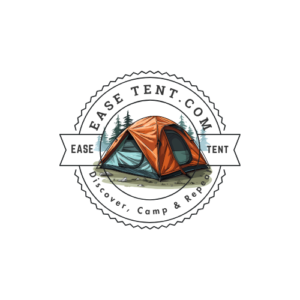
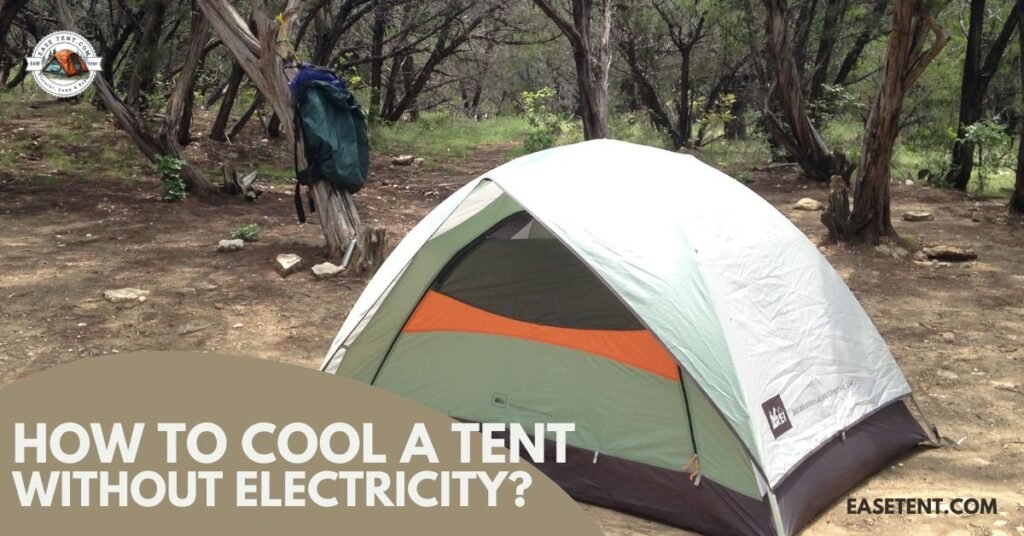
Pingback: How to Dispose of Camping Propane Tanks? - Easetent.com
Pingback: Camping in Foggy Weather: Magical Trip or Hidden Risk?
Pingback: What to wear while beach camping? Beach Camping Essentials